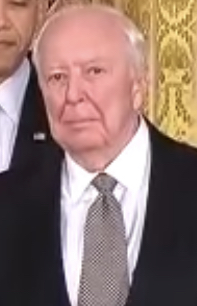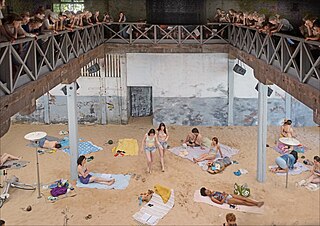
Jasper Johns is an American painter, sculptor, draftsman, and printmaker. Considered a central figure in the development of American postwar art, he has been variously associated with abstract expressionism, Neo-Dada, and pop art movements. Johns was born in Augusta, Georgia, and raised in South Carolina. He graduated as valedictorian from Edmunds High School in 1947 and briefly studied art at the University of South Carolina before moving to New York City and enrolling at Parsons School of Design. His education was interrupted by military service during the Korean War. After returning to New York in 1953, he worked at Marboro Books and began associations with key figures in the art world, including Robert Rauschenberg, with whom he had a romantic relationship until 1961. The two were also close collaborators, and Rauschenberg became a profound artistic influence.

The Venice Biennale is an international cultural exhibition hosted annually in Venice, Italy by the Biennale Foundation. The biennale has been organised every year since 1895, which makes it the oldest of its kind. The main exhibition held in Castello, in the halls of the Arsenale and Biennale Gardens, alternates between art and architecture. The other events hosted by the Foundation—spanning theatre, music, and dance—are held annually in various parts of Venice, whereas the Venice Film Festival takes place at the Lido.
Sarah Sze is an American artist and professor of visual arts at Columbia University. She has exhibited internationally and her works are in the collections of several major museums. Sze's work explores the role of technology and information in contemporary life utilizing everyday materials. Drawing from Modernist traditions, Sze's work often represents objects caught in suspension.

Simone Leigh is an American artist from Chicago who works in New York City in the United States. She works in various media including sculpture, installations, video, performance, and social practice. Leigh has described her work as auto-ethnographic, and her interests include African art and vernacular objects, performance, and feminism. Her work is concerned with the marginalization of women of color and reframes their experience as central to society. Leigh has often said that her work is focused on “Black female subjectivity,” with an interest in complex interplays between various strands of history. She was named one of the 100 most influential people in the world by Time magazine in 2023.
Kathy Halbreich is an American art curator and museum director.
The 58th Venice Biennale was an international contemporary art exhibition held between May and November 2019. The Venice Biennale takes place biennially in Venice, Italy. Artistic director Ralph Rugoff curated its central exhibition, May You Live in Interesting Times, and 90 countries contributed national pavilions.
The 53rd Venice Biennale was an international contemporary art exhibition held in 2009. The Venice Biennale takes place biennially in Venice, Italy. Artistic director Daniel Birnbaum curated its central exhibition, "Making Worlds".
The 49th Venice Biennale, held in 2001, was an exhibition of international contemporary art, with 65 participating nations. The Venice Biennale takes place biennially in Venice, Italy. Prizewinners of the 49th Biennale included: Richard Serra and Cy Twombly, Janet Cardiff and George Bures Miller, Marisa Merz, Pierre Huyghe, and Germany.
The 52nd Venice Biennale was an international contemporary art exhibition held in 2007. The Venice Biennale takes place biennially in Venice, Italy. Artistic director Robert Storr curated its central exhibition, "Think with the Senses, Feel with the Mind".
The 46th Venice Biennale, held in 1995, was an exhibition of international contemporary art, with 51 participating nations. The Venice Biennale takes place biennially in Venice, Italy. Prizewinners of the 46th Biennale included: Ronald Kitaj, Gary Hill, the Egyptian pavilion, and Kathy Prendergast.
The 45th Venice Biennale, held from June 13 to October 13, 1993, was an exhibition of international contemporary art, with 45 participating nations. The Venice Biennale takes place biennially in Venice, Italy. Prizewinners of the 45th Biennale included: ex aequo Richard Hamilton and Antoni Tàpies, Robert Willson, the German pavilion with Hans Haacke and Nam June Paik, and Matthew Barney.

The Belgian pavilion houses Belgium's national representation during the Venice Biennale arts festivals.

The Israeli pavilion houses Israel's national representation during the Venice Biennale arts festivals. Jewish Israeli artists first participated in the 24th Venice Biennale in the Erez Israel, Artisti Palestinesi pavilion. Israel first participated in the 25th Venice Biennale in 1950.

Sun & Sea (Marina) is an opera composed by Lina Lapelytė with a libretto by Vaiva Grainytė and directed by Rugilė Barzdžiukaitė, and presented as part of the 2019 Venice Biennale in a project curated by Lucia Pietroiusti. It won the festival's top award, the Golden Lion. The opera premiered in 2017 at the Lithuanian National Gallery of Art and was translated into English for the Biennale, where it served as Lithuania's national participation. It is set on a faux beach indoors, in which 24 performers partake in commonplace beach activities while singing about the causes and physical impacts of climate change in solo arias and group harmonies. The performance was a popular attraction with long wait lines at the Biennale. Multiple reviewers considered Sun & Sea (Marina) a highlight of the overall exhibition and The Guardian included it among the best performances of the year.
Martin Puryear: Liberty/Libertà is an art exhibition at the 2019 Venice Biennale's American pavilion featuring new works by sculptor Martin Puryear and curated by Brooke Kamin Rapaport. The Biennale is an international contemporary art biennial in which countries organize their own representation through national pavilions. Multiple journalists named the American pavilion an overall highlight of the Biennale.
The 59th Venice Biennale is an international contemporary art exhibition held between April and November 2022. The Venice Biennale takes place biennially in Venice, Italy. Artistic director Cecilia Alemani curated its central exhibition.
Cecilia Alemani is an Italian curator based in New York City. She is the Donald R. Mullen Jr. Director & Chief Curator of High Line Art and the artistic director of the 59th Venice Biennale in 2022. She previously curated the 2017 Biennale's Italian pavilion and served as artistic director of the inaugural edition of the 2018 Art Basel Cities in Buenos Aires, held in 2018.
Nino Longobardi is an Italian artist, known for painting and sculpture.
The 60th Venice Biennale is an upcoming international contemporary art exhibition to be held in 2024. The Venice Biennale takes place every two years in Venice, Italy. Artistic director Adriano Pedrosa will curate its central exhibition, Foreigners Everywhere.





